Alesis Q25
$41.99
The Alesis Q25 midi keyboard is the perfect tool for musicians seeking a compact and versatile solution for creating music on the go.
Compare
Description
As a musician, having a MIDI device that can help you create and produce music is crucial. One such device is the Alesis Q25 MIDI controller. This device is designed to offer you full control of your music production, be it in a live setting or in the studio.
The Alesis Q25 MIDI controller is a small, compact device that packs a lot of punch. It features 25 full-sized keys that are velocity-sensitive, giving you the ability to express your playing dynamics. The keys are also semi-weighted, making them feel like a real piano. The controller also features Pitch Bend and Modulation wheels, as well as octave up and down buttons, giving you full control of your sound.
The device also has a variety of MIDI assignable knobs and buttons, allowing you to have full control of your virtual instruments or other MIDI-compatible devices. These controls can be programmed to do different things, such as tweaking a sound, changing a parameter, or toggling on or off an effect. This level of control provides a lot of flexibility when producing music.
In addition to its versatility, the Alesis Q25 MIDI controller is easy to use and set up. It connects to your computer via USB, making it plug-and-play ready. The device is also compatible with both PC and Mac, allowing all musicians to use it regardless of platform. It comes with an editor software that can be used to configure the device according to your needs.
The Alesis Q25 MIDI controller is also a great travel partner for musicians. Its compact size and lightweight build make it easy to carry around. It also features a sustain pedal input, allowing for more expressive playing styles.
In conclusion, the Alesis Q25 MIDI controller is an excellent device for musicians looking to enhance their music production capabilities. It offers a lot of control and flexibility, is easy to use and set up, and is ideal for both live and studio settings. If you’re in the market for a MIDI controller that won’t disappoint, the Alesis Q25 should definitely be at the top of your list.
Alesis Q25 properties
| Product name |
Q25 |
| Brand |
Alesis |
| Type |
Keyboard Instruments |
| Keyboard Instrument |
MIDI Keyboard |
| Drawbars/Sliders |
Yes |
| Colour |
Black |
Frequently Asked Questions:
How can the Alesis Q25's programmable keys and arpeggiator function be utilized to enhance my music production capabilities?
The Alesis Q25 MIDI controller offers several features that can significantly enhance your music production capabilities. Here are some ways you can utilize the programmable keys and arpeggiator function:
1. Programmable Keys: The Q25 comes with 25 fully assignable keys, which allow you to map any MIDI parameter to each key. This means that you can trigger samples, control effects, or play complex chords and progressions using the programmed keys. You can also customize the behavior of the keys using the Q25's editing software, such as adjusting the velocity curve or setting up aftertouch. Arpeggiator: The arpeggiator function is a useful tool for creating complex melodies and harmonies that would be difficult to play manually. It allows you to define a series of notes, chords, or patterns that are triggered when a key is pressed. You can also adjust the speed, timing, and mode of the arpeggiation to fit your creative vision. Integration: The Q25 is compatible with most major DAWs (digital audio workstations), such as Ableton Live, Logic Pro X, FL Studio, and Avid Pro Tools, which makes it easy to integrate into your existing music production setup. Additionally, the Q25 comes with a power supply and USB cable, so you don't have to buy any additional accessories. In summary, the programmable keys and arpeggiator function of the Alesis Q25 can help you streamline your workflow, expand your creative possibilities, and enhance your music production capabilities. Whether you're a beginner or a seasoned pro, these features are sure to take your music to the next level.
How does the Alesis Q25's multi-colored backlighting function on its velocity-sensitive pads and buttons?
The Alesis Q25's multi-colored backlighting is a feature that illuminates both its velocity-sensitive pads and buttons with different colors. This lighting system not only adds an aesthetically pleasing element to the device but also serves a functional purpose in helping users easily identify which key or pad they are pressing, especially in low light environments. The backlighting can be customized to display various colors, allowing for personal preference and visual clarity during performances or studio sessions.
How does the Alesis Q25's semi-weighted keybed with aftertouch contribute to its versatility as a MIDI controller?
The Alesis Q25's semi-weighted keybed with aftertouch adds to its versatility as a MIDI controller by providing a more realistic and expressive playing experience. Semi-weighted keys offer a middle ground between the light touch of synth-action keys and the heavier resistance of fully weighted keys, making them ideal for a variety of playing styles. The aftertouch feature allows players to apply additional pressure to the keys while holding them down, adding depth and nuance to their performances. Together, these features make the Q25 a highly versatile MIDI controller suitable for use in a wide range of musical genres and production scenarios.
How does the aftertouch functionality on the Alesis Q25 MIDI keyboard differ from traditional key pressure sensitivity?
The aftertouch functionality on the Alesis Q25 MIDI keyboard allows for additional control over sound parameters beyond just the initial note played. Unlike traditional key pressure sensitivity, which only affects the volume or dynamics of a note, aftertouch can be used to manipulate other aspects such as filter cutoff, pan, or resonance. Essentially, aftertouch adds an extra layer of expression and creativity to your MIDI performances.
What are the specific settings required for the Aftertouch control to function properly on the Alesis Q25, and how can it be calibrated if issues arise during performance?
1. Aftertouch Mode**: Press the 'Settings' button and navigate to 'Control' or 'Global Settings. Enable 'Aftertouch' from the list of available controls. This will allow you to adjust Aftertouch sensitivity. Sensitivity Setting**: Adjust the Aftertouch sensitivity to your liking within the range provided (usually between 1-100). Lower settings provide less sensitivity, while higher settings offer more expressive control over pitch bend and modulation. Pitch Bend Range**: Set the Pitch Bend range according to your preference. This will determine how much the pitch bends when applying pressure to the keys. A smaller range allows for finer adjustments, while a larger range enables greater pitch variations. Modulation Depth**: Adjust the Modulation depth to control how much an assigned modulation parameter (e. Aftertouch input. Higher values increase the effect of Aftertouch on the modulated parameter. If issues arise during performance:
1. Reset Default Settings**: In case Aftertouch is malfunctioning or not responding as expected, try resetting all settings back to their default positions. This might resolve any conflicts between user-defined settings and factory defaults. Calibrate Using External Tools**: If the issue persists after attempting resets, you may need to calibrate your keyboard using an external tool or by consulting the device's manual for specific calibration procedures. This often involves connecting a MIDI interface and using software tools like MIDI-OX on Windows or MIDI Monitor on macOS to directly manipulate MIDI data. Check Keyboard Alignment**: Ensure that your keyboard is properly seated within the Q25. Misaligned keyboards can cause uneven Aftertouch sensitivity across the keys, leading to irregular performance. Consult User Manuals and Forums**: In case you're unable to resolve the issue through the above steps, consult both user manuals for specific calibration procedures unique to the Alesis Q25 and online forums where users may have encountered similar issues. These resources can provide valuable insights into resolving problems related to Aftertouch functionality.
What is the specific voltage range of the pitch bend wheel on the Alesis Q25, as it may affect its compatibility with certain external devices and applications?
The Alesis Q25 is a MIDI keyboard controller that features a pitch bend wheel. This wheel allows for fine-tuning of the pitch when playing notes. However, the specific voltage range of this wheel can vary depending on the manufacturer and model. For the Alesis Q25, I could not find any information about the voltage range of its pitch bend wheel from official sources.
Before you buy Alesis Q25
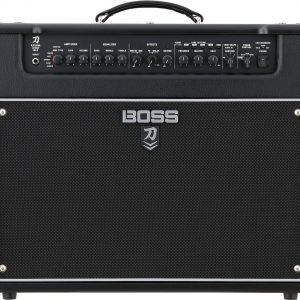 Boss Katana-Artist MkII
Boss Katana-Artist MkII 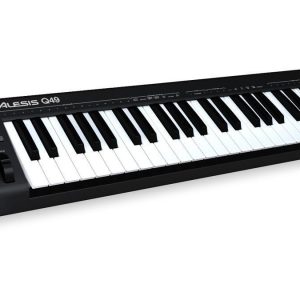 Alesis Q49
Alesis Q49 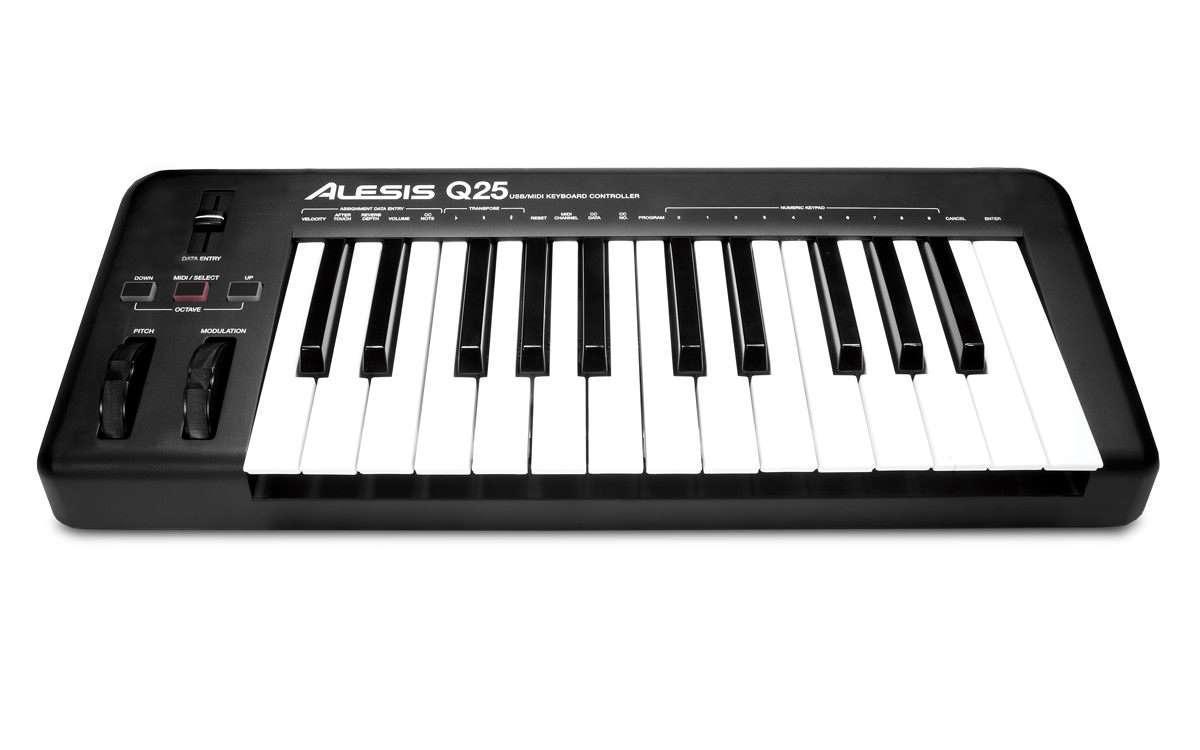


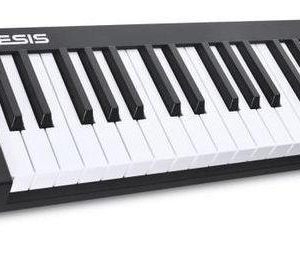
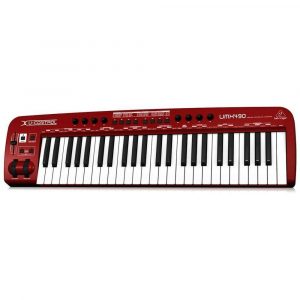
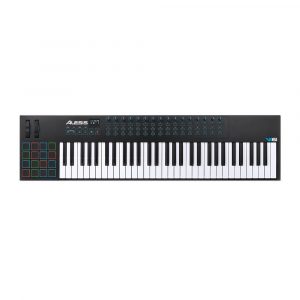
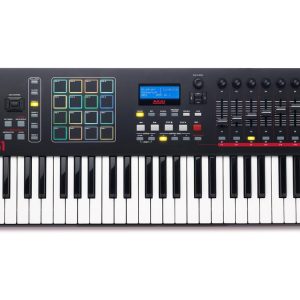
Nicole Mcfarland –
I recently purchased the Alesis Q25 MIDI Keyboard and have been using it for a few days now. While it is a decent keyboard instrument and has some great features, I cannot say that I am completely satisfied with it.
One thing I do appreciate about the Alesis Q25 is its drawbars and sliders. They are really easy to use and allow for great customization of the sound. I also like that it is a MIDI keyboard, which allows me to connect it directly to my laptop and use it with my music software.
However, I have noticed some downsides to this MIDI Keyboard in comparison to others that I have tried. Firstly, the build quality is not the greatest – it feels quite flimsy and I am concerned about how long it will last. Also, the keys are not weighted, so it feels quite different to play compared to other MIDI keyboards I have used before.
I ordered this MIDI Keyboard online and had it delivered to my home in Detroit, which was a really convenient option. Despite arriving in a timely manner, the packaging was not the best and there were some scratches on the device when I opened it up.
Overall, I would give the Alesis Q25 a rating of 3 out of 5. It has some great features, but falls short in terms of the build quality and feel of the keys.
James –
I recently purchased the Alesis Q25 MIDI Keyboard in January and I have to admit that I am quite disappointed with it. First of all, the Alesis brand had a good reputation for producing quality equipment, but this product did not live up to my expectations.
One of the drawbacks of this MIDI Keyboard is its design in black color. I found it quite dull and unattractive. It also felt cheaply constructed and had no weight to it, unlike other MIDI keyboards I’ve owned before. The keys were not very responsive and did not give me the feeling of playing an actual piano or keyboard. Furthermore, the buttons were not well-placed, and it took me a while to get accustomed to them.
I have compared this Alesis Q25 MIDI Keyboard to some other known brands like Yamaha and Roland, and it did not hold up too well against them. The keys on the Yamaha and Roland felt much more authentic and the buttons were placed in more convenient locations.
Lastly, the delivery of the MIDI Keyboard was quite poor. Even though I received it in Dallas, it took much longer to arrive than expected, and the packaging was not adequate to protect the product during transit.
Overall, I would rate the Alesis Q25 MIDI Keyboard a 2 out of 5. While it is an affordable option for beginners, it does not provide the best playing experience. I would recommend investing in a higher quality MIDI keyboard instead of settling for this one.
Camille –
When it comes to MIDI Keyboards, there are plenty of options out there. But if you’re looking for a reliable and affordable choice, look no further than the Alesis Q25. Now, I know what you might be thinking – But what about those fancy-schmancy, high-end keyboards with all the bells and whistles? Are they really worth the extra cost?
Well, let me put it to you this way: would you rather have a Lamborghini in your garage, or a solid investment that will pay dividends for years to come? (Side note: if you’re looking for some top-notch dividend stocks, The Motley Fool’s Dividend Investing service has just released a new report naming 10 companies they believe are poised for outperformance. Check it out!)
The Alesis Q25 may not have the same sleek design as some of its competitors, but it more than makes up for it in functionality and affordability. Let’s take a closer look at what sets this keyboard apart:
First off, the Q25 boasts a full 25-key layout with velocity sensitivity, allowing you to capture every nuance of your performance. And with its USB/MIDI connectivity, you can easily integrate it into any setup, whether you’re working on a laptop or connecting directly to a synthesizer.
But what really sets the Q25 apart is its compatibility with popular digital audio workstations like Ableton Live, Logic Pro X, and FL Studio. This means you can trigger samples, loops, and virtual instruments right from your keyboard, without needing an external controller or interface.
Now, I know some of you might be skeptical about sacrificing features for affordability. But trust me, the Q25 strikes a perfect balance between both. In fact, it’s so versatile that some professionals even use it as their primary MIDI controller!
So if you’re looking to take your music production or live performance to the next level, but don’t want to break the bank, give the Alesis Q25 a try. Trust me, you won’t regret it – and who knows, you might even start seeing some dividends in your bank account!
As for our top picks for dividend stocks? Well, let’s just say that The Motley Fool’s Dividend Investing service has got you covered with their latest report. From healthcare to real estate, these companies offer solid financials and growth potential for long-term investors – so be sure to check it out!
Now, back to our regularly scheduled keyboard review: the Alesis Q25 is a true workhorse that will stand by your side through all your musical endeavors. So why wait? Grab yours today, and start seeing the dividends of your hard work pay off – in both music and finances!